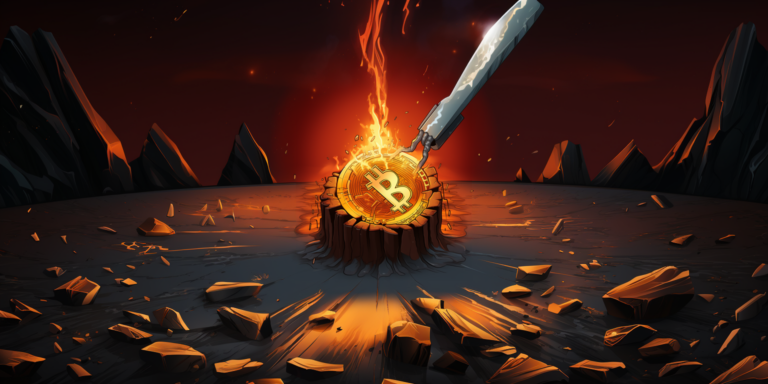
Share this article
In a matter of months, the world of Bitcoin and digital currencies will be experiencing another historic event – the fourth Bitcoin Halving expected in April 2024. This moment of anticipation and speculation serves as a high-stakes litmus test for both Bitcoin miners and the crypto market.
It is an event that has previously catalyzed monumental market shifts and could do so again.
JUST IN – We’re now 80% through to the next #Bitcoin halving.
HODL ON ✊ pic.twitter.com/OIeEmVLYBt
— Bitcoin Magazine (@BitcoinMagazine) July 14, 2023
Bitcoin halving is a unique feature of Bitcoin’s supply algorithm, where the rewards for miners are halved every 210,000 blocks of transactions – an occurrence approximately every four years. Satoshi Nakamoto, the creator of Bitcoin, linked the BTC’s creation to its anti-counterfeiting mechanism – the complex computational mining process that validates transactions on the blockchain.
Initially, a block’s mining reward was 50 BTC; by 2024, this reward is slated to be 3.125 BTC.
The question facing us now is how this halving will impact Bitcoin and the overall crypto landscape. Historically, halvings have been associated with skyrocketing price movements. The halvings in 2012 and 2016 sparked bull runs, with BTC valuations soaring by about 8,000% and 1,000%, respectively. More recently, the 2020 halving unleashed a run that peaked with a record Bitcoin price of nearly $69,000 in November 2021.
However, numerous factors contribute to the market’s complex dynamics. Bitcoin’s price movements have often coincided with other significant events, such as broader mainstream recognition, the proliferation of initial coin offerings (ICOs) and technological advancements.
The economic climate presents a potential dampener to the halving hype, with reduced expectations of U.S. Federal Reserve interest-rate cuts and stringent regulatory scrutiny of cryptocurrencies around the world. Predicting a halving-induced bull run is far from a secure bet. As skepticism surrounding the halving’s impact gains traction, other factors including macroeconomic trends and regulatory frameworks could take precedence over shaping Bitcoin’s price than the halving.
Meanwhile, Bitcoin miners – those who actually provide the industry with new BTC – are faced with a troubling reality. Bitcoin mining, already an operation demanding substantial resources, will become even more challenging with the dwindling rewards. A Bloomberg report interviewed Jaran Mellerud, a crypto-mining analyst at Hashrate Index, who predicted:
“Nearly half of the miners will suffer given they have less efficient mining operations with higher costs.”
A considerable portion of miners could see an increase of $.08 k/h, which could signal a potential consolidation or even an exodus within the mining industry, Mellerud predicted.
Wolfie Zhao, head of research of Blockbridge, told Bloomberg that currently, public mining companies pay $10,000-$15,000 per mined Bitcoin. However, estimates suggest that mining BTC will cost between $20,000-$30,000:
For the average Bitcoin holder, however, the halving’s impact will be mostly indirect. The event itself won’t change the amount of BTC in their holdings, but its potential effect on price will be the most significant.
It could also very well serve as a springboard for another cyclical bull run or bring in a period of turbulence and consolidation. While the answer remains unclear, one thing is certain: the coming months will be a defining period for Bitcoin, its miners and the global cryptocurrency ecosystem.
Share this article
- SEO Powered Content & PR Distribution. Get Amplified Today.
- PlatoData.Network Vertical Generative Ai. Empower Yourself. Access Here.
- PlatoAiStream. Web3 Intelligence. Knowledge Amplified. Access Here.
- PlatoESG. Automotive / EVs, Carbon, CleanTech, Energy, Environment, Solar, Waste Management. Access Here.
- BlockOffsets. Modernizing Environmental Offset Ownership. Access Here.
- Source: https://cryptobriefing.com/bitcoins-2024-halving-market-catalyst/?utm_source=feed&utm_medium=rss
- :has
- :is
- :not
- :where
- 000
- 1
- 14
- 2012
- 2016
- 2020
- 2021
- 2024
- 24
- 32
- 50
- 500
- 7
- 8
- a
- About
- above
- Accept
- accessed
- accuracy
- accurate
- actually
- advancements
- advice
- advisor
- again
- algorithm
- All
- already
- also
- amount
- an
- analyst
- analyzing
- and
- Another
- answer
- anticipation
- any
- approximately
- April
- April 2024
- ARE
- around
- AS
- associated
- At
- average
- based
- BE
- become
- been
- believe
- Bet
- Bitcoin
- Bitcoin halving
- Bitcoin Magazine
- Bitcoin Miners
- Bitcoin mining
- Bitcoin Price
- blockchain
- Blocks
- Bloomberg
- both
- Bottom
- bring
- broader
- BTC
- bull
- Bull Run
- but
- by
- Catalyst
- certain
- challenging
- change
- class
- Climate
- Coin
- coincided
- coming
- Commodities
- Companies
- Compensation
- complex
- considerable
- consolidation
- contribute
- Cost
- Costs
- could
- creation
- creator
- crypto
- crypto landscape
- Crypto Market
- cryptocurrencies
- cryptocurrency
- cryptocurrency ecosystem
- currencies
- Currency
- Current
- Currently
- cuts
- Cyclical
- decision
- defining
- demanding
- digital
- digital currencies
- do
- dynamics
- Economic
- ecosystem
- effect
- efficient
- estimates
- Even
- Event
- events
- Every
- everything
- Exodus
- expectations
- expected
- experiencing
- faced
- facing
- factors
- far
- Federal
- federal reserve
- financial
- financial advice
- For
- form
- four
- Fourth
- from
- Gains
- Give
- given
- Global
- Half
- halved
- Halving
- Hashrate
- Have
- head
- higher
- historic
- historically
- holder
- Holdings
- However
- HTTPS
- Hype
- ICO
- ICOs
- IEO
- if
- Impact
- in
- inaccurate
- Inc.
- Including
- Increase
- independent
- index
- industry
- information
- initial
- initial coin offerings
- investment
- IT
- ITS
- itself
- landscape
- less
- Licensed
- linked
- magazine
- Mainstream
- make
- MAKES
- many
- Market
- Matter
- May..
- mechanism
- Media
- mined
- Miners
- Mining
- Mining BTC
- Mining Companies
- Mining Industry
- moment
- months
- monumental
- more
- most
- mostly
- movements
- nakamoto
- nearly
- negative
- net
- never
- New
- next
- no
- Notice..
- November
- November 2021
- now
- numerous
- obtained
- of
- Offerings
- often
- on
- ONE
- operation
- Operations
- or
- Other
- otherwise
- over
- overall
- Pay
- peaked
- per
- period
- Personalized
- plato
- Plato Data Intelligence
- PlatoData
- potential
- predicted
- predicting
- presentation
- presents
- previously
- price
- process
- professional
- profits
- provide
- public
- qualified
- question
- RE
- Reality
- recently
- recommend
- record
- Reduced
- regulatory
- reliable
- rely
- remains
- report
- Reporting
- representation
- research
- Reserve
- Resources
- Reward
- Rewards
- Run
- runs
- s
- sales
- Satoshi
- Satoshi Nakamoto
- scrutiny
- secure
- Securities
- see
- seeking
- serve
- serves
- shaping
- Shifts
- should
- Signal
- significant
- Skepticism
- So
- soaring
- some
- Sources
- sparked
- speculation
- strongly
- subject
- substantial
- suggest
- supply
- Surrounding
- Take
- technological
- terms
- test
- than
- that
- The
- the information
- the world
- their
- they
- thing
- this
- those
- Through
- to
- tokenized
- top
- Total
- traction
- Transactions
- Trends
- troubling
- true
- turbulence
- TURN
- u.s.
- U.S. Federal Reserve
- unique
- unleashed
- Update
- us
- Valuations
- very
- was
- we
- Website
- WELL
- which
- while
- WHO
- will
- with
- within
- without
- world
- years
- you
- zephyrnet
- Zhao










